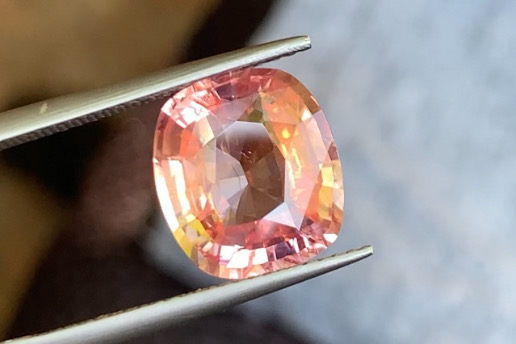
If you had been up to speed with the British royal family back in 2018, you couldn’t have missed the breathtaking engagement ring Princess Eugenie was proposed with. The rosy orange sapphire haloed by a ring of round cut diamonds enchanted the beholders in awe. It was rare, it was magnificent, and it was a Padparadscha - a name synonymous with exclusive exquisiteness. Padmaraagas, Padmaraajas, or Padparadschas as they are commonly known are a type of rare sapphires at the top of the sapphire hierarchy. With regard to the name and its origin, there are scholars who disagree with the name Padparadscha, claiming it to be a misnomer and the correct name to be Padmaraaga - A Sanskrit-derived Sinhala word that means “Lotus Color'' as “Padma” means “lotus” and “Raaga” stands for ‘color’. Whichever the right name may be, this precious gemstone lives up to it in its shades of rosy and sunset hues and extreme rarity and beauty.
Padparadschas are also known as Salmon sapphires, again due to their unique hues. These sapphires have clear, light hues of pink and orange and thus bring out the color of a lotus in the sunset. Vivid mixes of pink and orange colors or sapphires zoned with yellow and pink are cherished among the knowledgeable, but darker tones might disqualify a sapphire from being a Padparadscha. It must be understood that the correct color tonality and saturation of a perfect Padparadscha is always debatable.
The natural rosy sunset color of Padparadschas makes them desirable, and what makes them more so is their clarity. The natural occurrence of the desired hues of these precious gems in their desired clarity or lightness is extremely rare. Also, an inclusion inside this gemstone would clearly be visible to the naked eye due to its clear light hue. Therefore an untreated, clear Padparadscha in its natural mixture of pink and orange is more sought after than the rarest rubies and emeralds. If we take a look at the composition of these pristine gems, in their absolute form, they are corundum gems made of Aluminium Oxide, the same as other sapphires. But they consist of specific concentrations of Chromium and Iron that give them their distinguished sunset rose hue. Padparadschas score a 9, just shy of a Diamond’s 10, on the Mohs scale of hardness and sport, as observed above, a weak, dual shade in body color.
The best source of natural Padparadscha sapphires is, as unanimously agreed, is Sri Lanka which was the only source of these sapphires for a long time. Lately, Tanzania, Madagascar, and Vietnam also gave birth to this special sapphire in their earthly wombs, with slightly varied hues and tones. But the best specimens of Padparadschas are from Sri Lanka, leading some experts to declare that only salmon-colored sapphires from Sri Lanka should be called Padparadschas!
Due to their extreme rarity as natural crystals in nature, Padparadscha crystals found as such from mining are cut with precision and caution. Because the specific color tones of the precious stone may be cut off and wasted, Padparadschas are sometimes fashioned into asymmetric or uneven cuts. And as a result, they may better be suitable to be crowned on a piece of jewelry or accompanied by an escort of other precious stones rather than being on their own as a standalone jewel.
This rarity and extreme desirability of Padparadschas had catalyzed the professionals to try and adopt the specific desirable features through various artificial processes. Heat treatment is used to improve the color of Padparadschas which is of course an accepted process to be used on sapphires, and a properly heat treated Padparadscha will be almost as valuable as an untreated natural Padparadscha because the heat treatment on a Padparadscha is delicate and uses low temperatures. However, rather controversial processes have also been originated to replicate Padparadscha characteristics in other, lesser craved sapphires. Beryllium diffusion is one such process, where pink sapphires are heated with Beryllium to high temperatures to get the signature salmon tone of Padparadschas. This method specifically came into the spotlight in the 1990s where a sudden surge of Padparadschas flooded the market despite their rarity. And it was later found that these were all Beryllium diffused artificial Padparadschas that have merely assumed the characteristics of Padparadschas. Radiation, dying and oiling are other ways an undesirable Padparadscha would be made.
That being said, if a natural, treated or untreated Padparadscha adorns your or your beloved’s skin, preferably seated on a rose gold crest of jewelry to complement its clear sunset lotus beauty best expressed in natural twilight as observed by sapphire savant Richard W. Hughes, hailed by its flock of gemstone subjects and glimmering in all its exquisite clarity, rest assured. That right there, second to none, is the king sapphire, beloved and cherished by all.